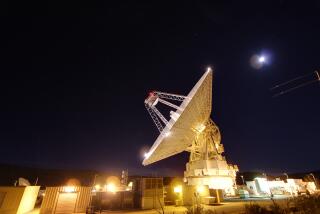The Shuttle Is a Model T in the New Space World
- Share via
The National Aeronautics and Space Administration may have to be dragged kicking and screaming into the 21st Century.
A host of new technologies are evolving, offering the promise of vast advances in space flight. Yet NASA has resolutely stuck to pursuing a series of goals from decades past, using the old-fashioned technology of rockets.
NASA wants, first, a space station--a larger version of Skylab, which we launched in 1973. And, for the more distant future, NASA still hopes to send astronauts to Mars, at enormous expense, again using rockets. This goal has been dear to its heart since the 1960s. No matter that we sent an advanced robot lab to land on Mars in 1976, and could easily do so again. No, NASA says, only astronauts will do.
This tenacious hold on old technical chestnuts, this unwillingness to pursue new goals, is the symptom of a fossilized bureaucracy that pursues only government-approved dreams. NASA today is staffed mostly by old-timers who have been there for decades. It attracts few young people with fresh ideas.
But, in the wake of the Challenger disaster, NASA’s very existence will be questioned, and its aims reexamined and defined anew. From Challenger’s ashes may rise a new space program for the next century.
NASA management should commit its efforts to “impossible” goals that stretch the limits of what we can foresee as feasible. The agency’s motto should be, “Do the impossible, and do it well.” Such goals would stimulate young people, attract the involvement of entrepreneurs and spur new technologies. These goals should have a common theme: to develop the infrastructure of space to support the most ambitious efforts of the next century.
First, NASA should develop jet-propelled aircraft that can fly to orbit. NASA is already joining the Air Force’s aerospace-plane project--but in a junior role. Using new engines and lightweight materials that now are in active development, such aircraft would have cargo bays nearly as large as the fuel tanks. By contrast, the shuttle’s main fuel load is 25 times heavier than its cargo.
With such craft, or with even more advanced ones, NASA could pursue a second goal: the reduction of launch costs to $15 per pound of cargo carried to orbit. This contrasts with the $5,000-per-pound costs of the shuttle. With such low cargo costs the nation’s builders and entrepreneurs could undertake construction in space on a large scale.
At that price space flight would enter our lives as aviation entered our parents’ world. We could rely on spaceborne aircraft for flights halfway around the world in little more than an hour. The Pacific Rim would boom amid such fast and easy transportation. People would take vacations in orbit, thus experiencing space travel at first hand.
A third goal would open up the entire solar system for flight. Rather than rely on conventional rockets, NASA must develop new engines powered by nuclear reactions. Much of the needed technology may flow from the “Star Wars” program. Such craft would operate only in deep space, never landing on Earth. But they could fly to Mars in as little as nine days.
A fourth goal would develop the capacity to undertake large-scale construction in space, using raw materials taken from the moon or the asteroids. We could routinely transport moon rocks on an industrial scale, extracting their valuable metals, silicon and oxygen. Then, using sophisticated robots, we could build orbiting cities, solar-power satellites the size of Manhattan, interplanetary spaceships and the ultimate telescope that could see objects the size of houses on planets of nearby stars.
Once these goals were accomplished, NASA could support the vastest space projects of the next century. We might undertake the large-scale deployment of Star Wars systems for missile defense. The colonization of space could go forward. The entire solar system would be open to widespread exploration. New energy sources, relying on solar power from space, could supplement our waning oil reserves.
Can we afford such things in a nation that needs subways and help for the homeless? A reasonable rule to follow is, “If you can’t do it easily--don’t push.” The shuttle is expensive because engineers have pushed the rocket, a marginal technology, to its limits, forcing it to do more than it can readily accept.
By contrast, tomorrow offers a host of new technologies--in robotics, in advanced engines, in the use of computers for design, in lightweight materials. With them, space flight, even on a vast scale, may be accomplished with relative ease. These technologies will be as far beyond the shuttle’s as a jetliner is beyond a steamship. And these technologies, used in space, will also enter and transform the way we do things here on Earth, thus helping to secure our future prosperity.
More to Read
Sign up for Essential California
The most important California stories and recommendations in your inbox every morning.
You may occasionally receive promotional content from the Los Angeles Times.










